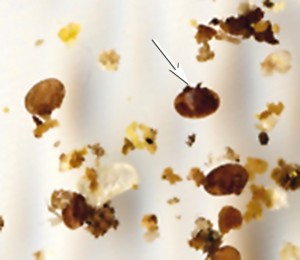Progress is accomplished by people devoted to find solutions to problems and make life easier for all of us. When people are dedicated for a task, we should be grateful and try to help if possible. Sometimes though it may be that instead they are opposed as they may be seen as threats to ones own line of thoughts and career.
The first priority, which benefits all of us in the long perspective is to find truth and true knowledge. No one has the whole perspective and see everything correct. The picture of reality is like a jigsaw puzzle and we find the pieces in the correct places one by one.
One of these devoted beekeepers is Alois Wallner in Austria. In 1989 he began selecting bees for what he called the killer factor. He saw that some of the mites in the natural downfall of mites on the bottom board were damaged. Often pieces of one or more legs were missing. If 50 of 100 mites in the downfall were damaged, the killer factor is 50%. From a very low rate it is now up to 100 %. It has taken him 20 years with his 700 bee colonies. Evidently you can’t get more than 100 % killer factor.
He has always used Formic acid to treat against mites in his Carniolan bees. In the beginning he found that 4 treatments a year was needed. Now it’s enogh with two, according to his website http://www.voralpenhonig.at/default_en.htm
The conclusion is that it takes a long time to select the way he did, and you don’t get bees that all by themselves can handle the mite. Evidently the selection criteria was good to help the bees halfway to the goal. Why not wholly? Probably because the bees can’t catch enough many mites early enough. So they get time to enter brood cells and reproduce.
This is good to know. Killer factor is beneficial, but you have to find also other selection criteria and maybe other parts in a breeding and management strategy than what Wallner is using, if you want to go the whole road.

To quantify the impact of varroa killing or killer factor (KF) like Wallner named on varroa resistance, one would need in the ideal world a bee that uses this resistance trait solely. However, Wallner reported that his bees express VSH activity as well. Hence, to quantify his KF effect, one would either need to pair queens with single drones from 0% VSH material like Harbo did (Journal of Apicultural Research and Bee World 48(3): 156-161 (2009), to achieve bees with 0% VSH but 100% KF. (This would be the time consuming scientific approach…). Or maybe simpler, he might have a look on his stock, whether there are hives that have already 0% VSH but 100% KF.
Anyway, I would assume that there is a significant contribution of KF on varroa resistance, as this trait is existent in the Primorski bees as well, which have underwent cooevolution with varroa mites for more than 200 years.
Additionally, varroa killing is the most elegant way to get rid of mites, as this is not costly for the bees. In contrast, VSH requires the elimination of brood and hence already invested resources.
Although Wallner claimed in his german homepage that he has special hives that need no varroa treatment for 6 years now, his producer hives need still 2 x treatment and Eric asked why he could not generally refuse the varroa treatment, although KF is already 100%. The answer he gave was: “Probably because the bees can’t catch enough many mites early enough. So they get time to enter brood cells and reproduce.”
The same question was raised by Wallner himself as well and consequently he looked for a more stringent selection control (since 2009/10) that measures the speed of varroa killing. (again only on german home page) What this exactly is, has not been reported in his homepage, however, maybe readable in the contribution of the January issue of the Austrian Beekeeper Journal. Let’s see.
Looking at several videos about mite bee interaction, it seems that mites can run pretty fast and bees have difficulties to catch them effectively. Maybe his selection scheme concentrates now on bees that injure mites on the body of bees already, because mites are somehow immobilized. But this is speculation and again let’s waits whether we can learn more, when his article is published.
Rüdiger
Yes, like in Apis cerana I think that grooming and biting mites is a good mix with VSH and HYG in Varroa resistance, also in Apis mellifera. That grooming and killing mites can be a part also in Mellifera yoou can see in the video of Elgon bees with Sven Olof Ohlsson in Finland (even if it’s no Primorski heritage). http://home.agrolink.net/so.ohlsson/movies/VTS_01_1.flv
The way Wallner selected for KF may be an explanation why the bee need more than KF to be totally resistant. But I suspect that resistant honeybees will always have different traits in combination to reach resistance, like KF and VSH, but also HYG and virus resistance. But I think it’s valuable that Wallner is investigating KF in depth the way he is doing.